Some years ago on a study tour, I was blessed to visit the Basilica of San Clemente in Rome and to feast my eyes on its exquisite mosaic-covered dome that dates back a thousand years. It is one of the best-preserved works of Christian art in the world and creates the backdrop to the church’s sanctuary as it spans about forty feet across and maybe twenty or twenty-five feet deep.
When I walked into the church it took a few moments for my eyes to adjust to the darkened space, but then someone flipped on the lights of the sanctuary, and the entire space above the altar transformed from a dark cavern looming over our heads to an absolutely radiant vision of color, beauty, delicacy, grace, and glory. Trust me, the picture doesn’t do it justice:
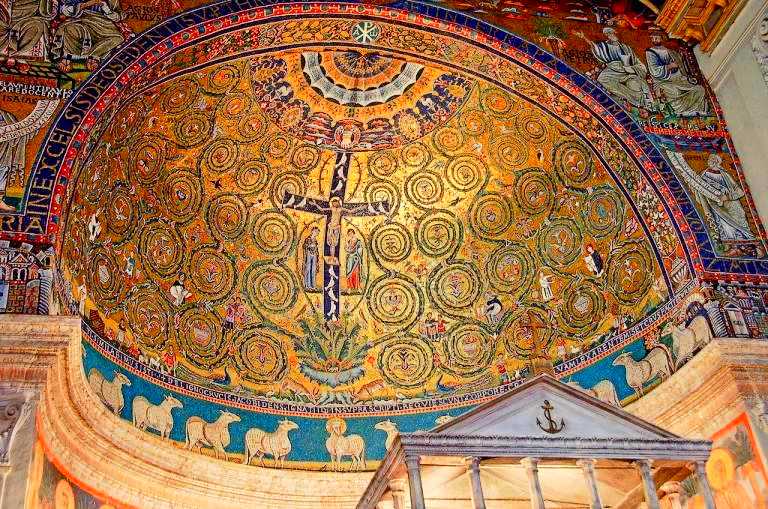
The Theology of Domes
That burst of shimmering gold and colorful detail overwhelmed my senses for the rest of my visit and created a deep, lasting impression on my soul. But then again, it was meant to have that effect on people. The dramatic color, beauty, and light effects were not extras to the religious artist who created the design. These are the very properties of heaven! But that’s essentially the theology of domes, isn’t it?
We physically stand on the ground and look up at a dome in the same way we exist as physical beings on this earth and spiritually raise our eyes to heaven. Dome art has this as its primary purpose: to lift our hearts and minds to heaven, to fill our souls with radiant beauty and make us long for our eternal home.
It stands to reason that scenes of heaven like San Clemente’s would dominate the church domes everywhere and that they would be among the most beautiful of all artistic creations.
Domes in DC
Happily, the memory of San Clemente reminded me of our own Basilica of the National Shrine of the Immaculate Conception in Washington DC (hmm, that’s a mouthful – I’ll just call it the National Basilica for short), and I’d like to draw the readers’ attention to two magnificent and imposing domes among the numerous domes featured in the Basilica. They are examples of dome art at its finest.
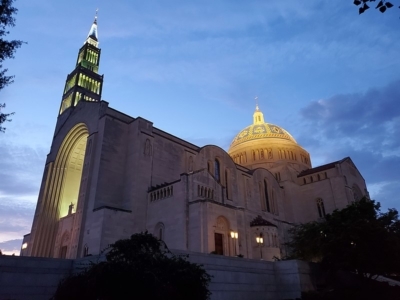 First, I should note that our National Basilica (Catholic) in the Northeast section of DC is not to be confused with the National Cathedral (Episcopal) on the Northwest side of DC. The latter is an exquisite Gothic cathedral in its own right and probably worth its own Sacred Windows Newsletter in the future (haha).
First, I should note that our National Basilica (Catholic) in the Northeast section of DC is not to be confused with the National Cathedral (Episcopal) on the Northwest side of DC. The latter is an exquisite Gothic cathedral in its own right and probably worth its own Sacred Windows Newsletter in the future (haha).
But domes are not usually features of Gothic churches (a style that originated in the Medieval era). Gothic architecture is characterized by majestic columns, soaring pointed arches, and magnificent stained glass windows: as I said, beautiful in its own right.
Rather, domes are wide and usually cap off broad aisles, spaces, or junctions in the architecture. They better fit what is called the “basilica” style of church (characterized by a wide main aisle flanked by monumental columns or pillars). The basilica style is characteristically Byzantine (a pre-Medieval, eastern style) or Renaissance/Baroque (16-20th centuries, primarily Romanesque style).
Our National Basilica is a fusion of both the Byzantine and Romanesque styles with a 329-foot bell tower and as many as eighty small chapels dedicated to Our Lady under her various titles, apparitions, and international devotions.
There are domes, mosaics, and brilliant religious artwork everywhere you look. It is also one of the largest churches in our country – just walk into it and you’ll see why! Its size and grandeur are simply overwhelming.
Heavenly Reminders
What I like most about our National Basilica, though, is that it takes this preparation for heaven business seriously in two of its dome scenes that are heavenly in a very real sense but that might also be minority features in the theology of glorious domes. These two domes emphasize the Final Judgment and the final battle against the seven-headed dragon.
Most of the other domes in the Basilica do what domes normally do and emphasize the glories of heaven, but these two unique domes throw some cold water on anyone looking only for a pious, happy feeling about heaven. We might say that these domes are pre-glory domes because they remind us that we have a test to undergo before we reach that heavenly bliss.
I love the glorious domes of the Basilica, but I deeply admire the cold-slap-in-the-face domes. They are like the difference between a friend you love with all your heart and another friend who you may not like all that much but respect because tells you the unvarnished truth about yourself to keep you from going off the rails. We need both types of friends, but one is more valuable for the ultimate things like the Final Judgment.
The names of these domes are 1/ the “Pantocrator” dome and 2/ the “Woman Clothed with the Sun” dome. They hover next to each other in the very back of the basilica (called the Apse.) If you haven’t already seen them with your own eyes, make sure to go to DC and visit the Basilica before the impending Apocalypse overtakes our country. And bring binoculars!
The Pantocrator Dome
It’s hard to get a feel for the size and majesty of this dome unless you are standing under it. The mosaic that decorates the dome covers 3610 square feet of space – wow.
And if you’re wondering what that strange word, Pantocrator, means, it’s a hybrid of two Greek words, pantos (all) and krateo (to hold). Literally translated: “The One Who Holds All Things”. The official name of the mosaic is “Christ in Majesty.” Some call it Christ the Judge, but it’s most adequate name is the traditional term, Pantocrator, which places it squarely in the long history of Christian art and domes.
It is an interesting designation for our Blessed Lord, but it is entirely consistent with the biblical revelation of Christ who is described as the one through whom everything came into being (John 1:1-3) and “The one who holds the seven stars [i.e., the universal church] in his right hand” (Revelation 2:1), among many other similar references. When you see how Christ is pictured on this dome, you’ll notice that the One Who Holds All Things really means business about the matter of our salvation.
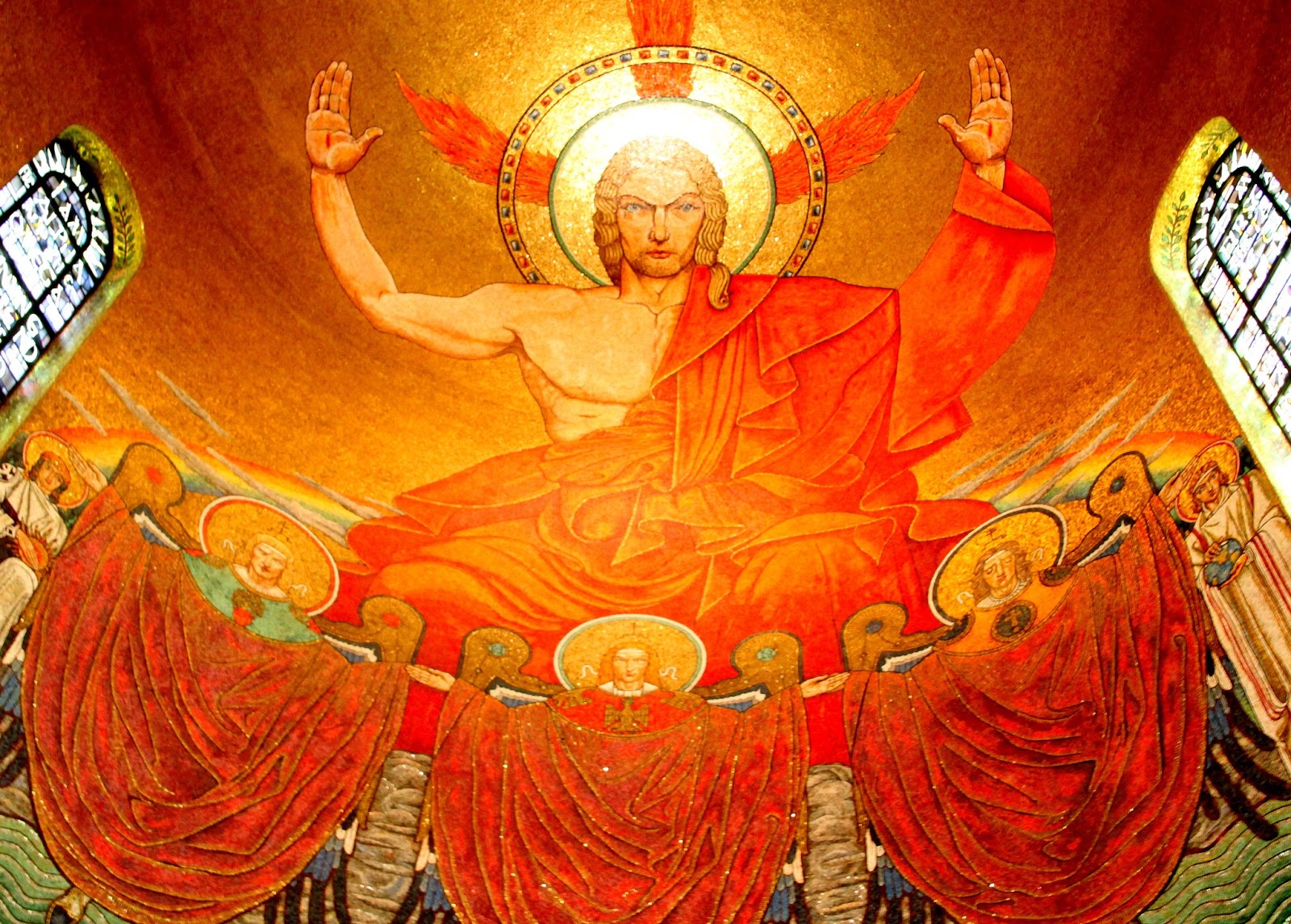
The bracing character of this dome is evident and well expressed by numerous of its artistic details:
- Gold is everywhere to signify His divine authority;
- His arms are raised in the gesture of the High Priest at prayer;
- He has a double halo as a sort of celestial crown;
- A deep blood red imbues His garments and three shafts of fire shoot from His head to express His overwhelming life and power;
- Notice the bodybuilder physique (typically American, right?) to show His indomitable strength;
- Priestly angels and saints wait in attendance on Him to manifest His sovereignty over all creation;
- The throne upon which He sits is a rainbow to designate Him as the ultimate executor of God’s covenant with man; and
- His demeanor and piercing blue eyes menace the viewer with the severest of severe faces to tell you He means business. He is final Judge of all human conduct, the King of Kings and Lord of Lords of all creation.
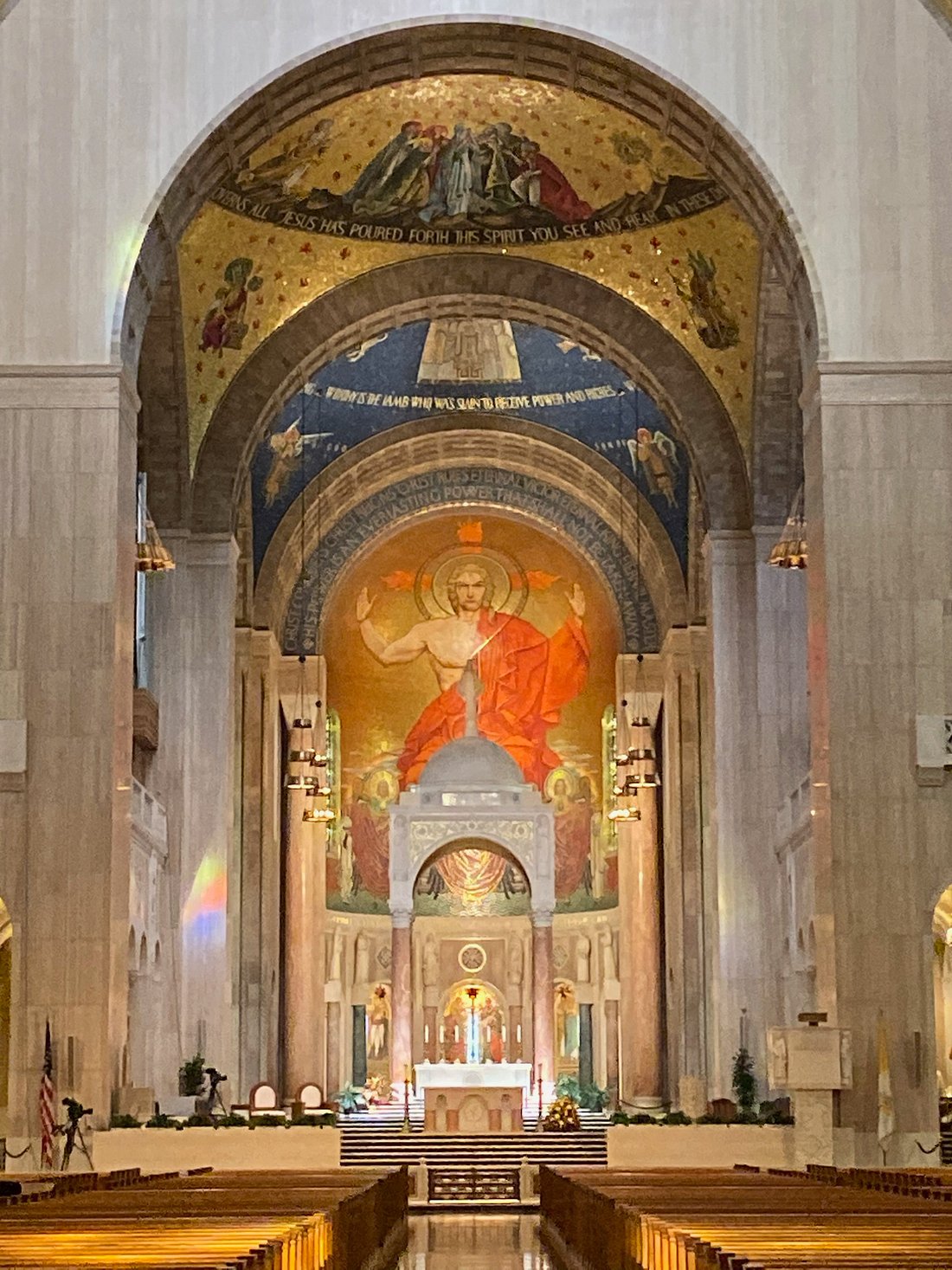
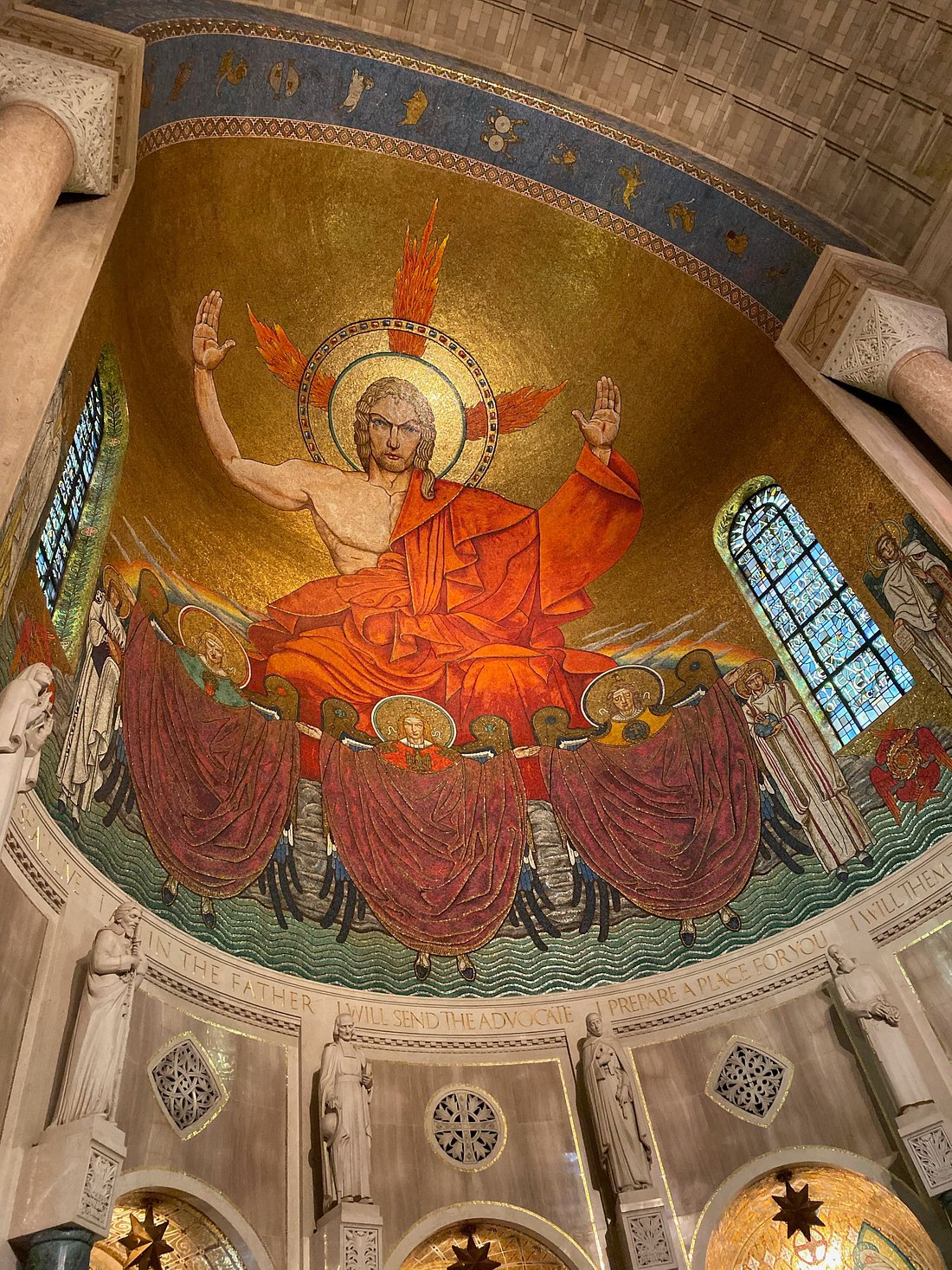
This dome is visible from all primary vantage points in the massive Basilica and is meant to give the viewer a bracing call to repentance, self-examination, and humble submission to the divine authority.
Now, lets look at its companion dome.
The Woman Clothed with the Sun Dome
If you were standing in front of the Pantocrator Dome and made one quarter turn to your left, you would see the Woman Clothed with the Sun dome. It depicts that awful scene in Chapter 12 of the Book of Revelation when the seven-headed dragon, the devil, attempts to devour the Child who was destined to save the nations (Revelation 12:1-9). The mosaic features a radiantly beautiful image of Our Lady as she is described in Revelation and a terrifying view of the Evil One as he appears in verses 3-4 of the same passage.
It’s a hard image to contemplate. It should be. The reality of evil is a hard subject to swallow:
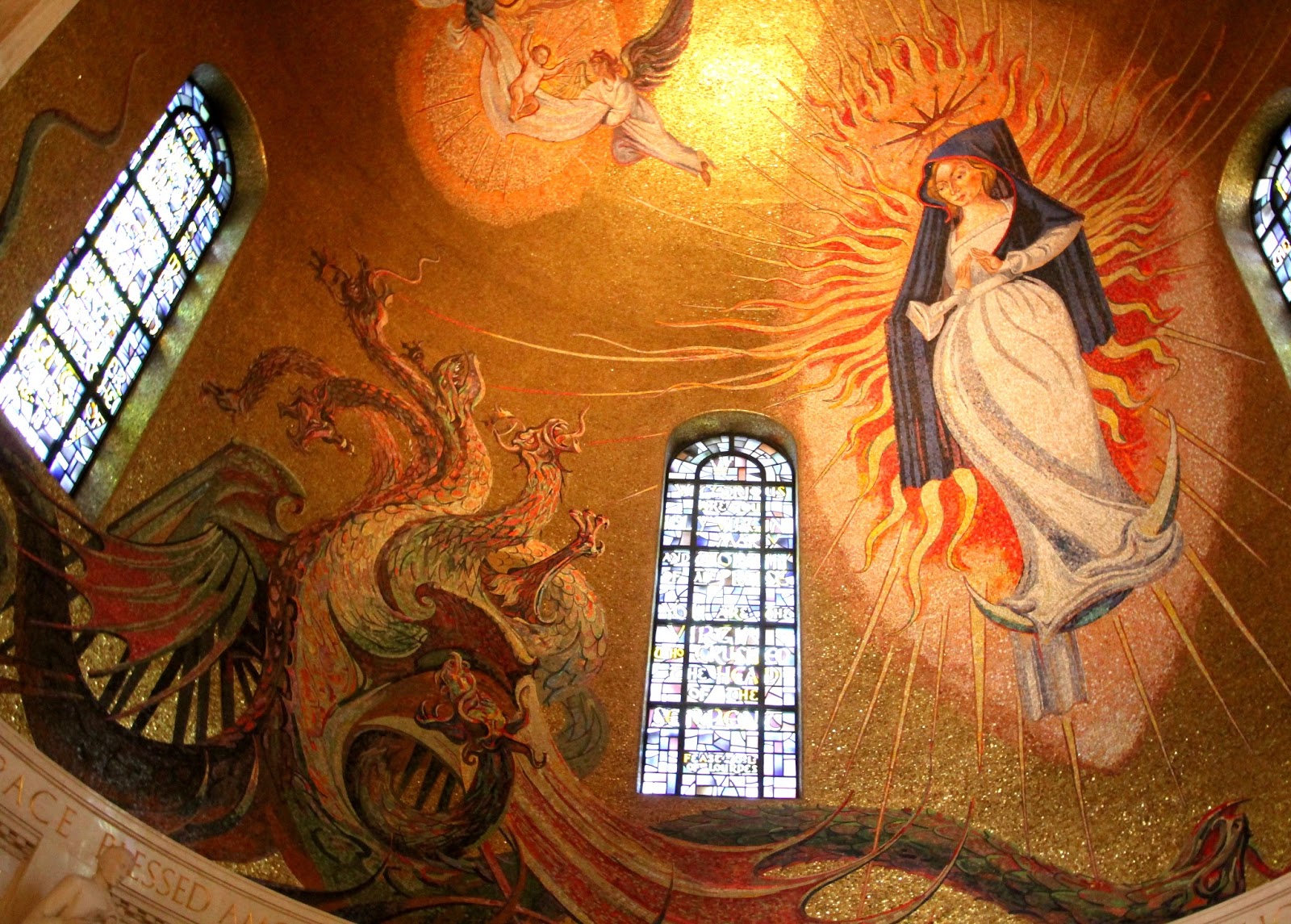
You could spend an hour looking at every detail of this mosaic, but I’ll just point out a few key images and aspects of it:
- The dome is arrayed with a gold-flecked background and a shock of golden light at the top to signify the glory of heaven that Our Lady already shares;
- The three figures appear in a triangular arrangement (with the Baby at the top);
- The Baby has been snatched away from the devouring beast and is guarded by angels (as prophesied by Revelation 12:5);
- The figures of the woman and the beast are cleverly positioned in the dome wall with a stained glass window between them, and Mary hovers higher than the devil who shrinks back at her radiance;
- Long rays of the woman’s light reach out to the heads and tail of the dragon to restrain his power;
- The dragon is the very essence of a disgusting, snake-like, bat-winged, horrifying, ferocious monster;
- The woman wears a crown of twelve stars and, like the Pantocrator, is depicted in a gesture of prayer.
Frightening Us or Blessing Us?
The Church’s doctrine of the Four Last Things (Death, Judgment, Heaven, and Hell) doesn’t get prime billing in most religious writing today. These are essential issues, though, and while it would be wrong to obsess about them, they cannot be ignored and should not be taken lightly. Although it is filled with other wondrous religious art and glorious domes, our National Basilica does not gloss over the essential subjects.
Should the Final Judgment and the Devil frighten us? The answer is both yes and no, “but mostly yes” as a friend of mine reminded me.
There is a holy fear (Fear of the Lord) which the Old Testament tells us is the “beginning of wisdom” (Proverbs 9:10) and the Church tells us is one of the seven gifts of the Holy Spirit (Catechism, 1845). “Fear” in this sense is reverence, humility, obedience, and devotion to the Will of God out of respect for His Truth.
The reality that we will all be called to “stand before the judgment seat of Christ” (2 Corinthians 5:10) should fill us with that kind of holy fear.
Fear of the Evil One is just as real – in the sense of respect for his malevolent power – but we live in the freedom of the children of God who protects us from evil and guides us to glory.
Remember: That Baby who appears at the top of one dome after being snatched from the power of the devil is the same Person who appears in majestic glory on the other dome as the “One Who Holds All Things.”
In His hand, we have absolutely nothing to fear.
———-
[Note: This article is a reproduction of the Sacred Windows Email Newsletter of 9/18/22, so it does not end with the regular Soul Work section. Please visit our Newsletter Archives.]
Images: via Wikimedia Commons. Feature Image: Farragutful, CC BY-SA 4.0, via Wikimedia Commons.
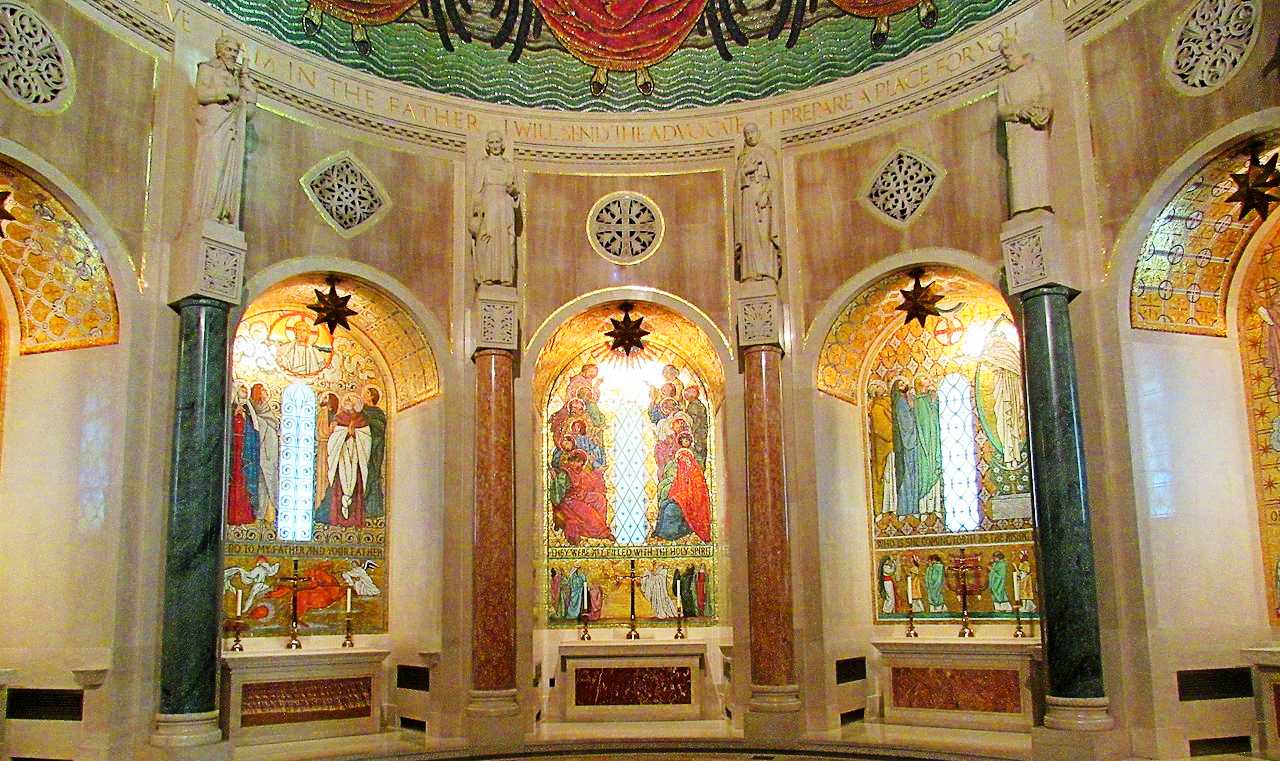
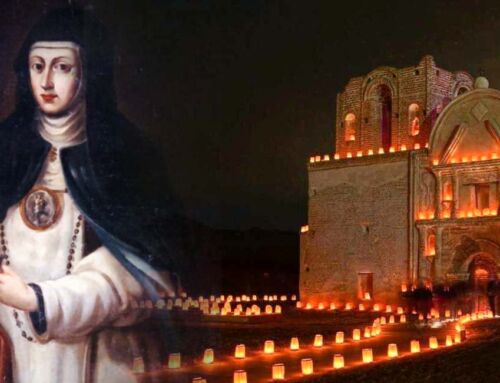
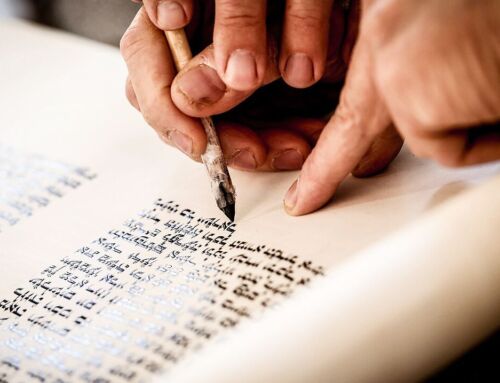
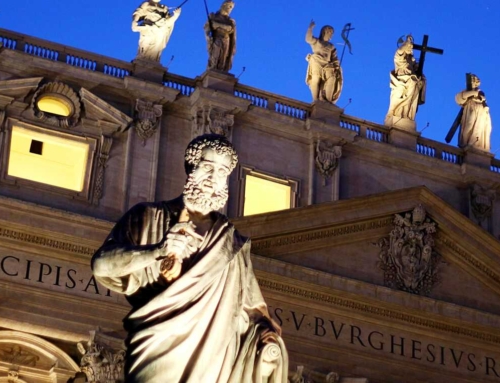
Leave A Comment